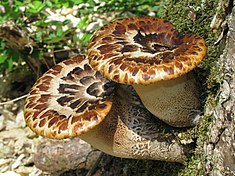Polyporus squamosus
| Polyporus squamosus | |
|---|---|
 |
|
| Scientific classification | |
| Kingdom: | Fungi |
| Phylum: | Basidiomycota |
| Class: | Agaricomycetes |
| Order: | Polyporales |
| Family: | Polyporaceae |
| Genus: | Polyporus |
| Species: | P. squamosus |
| Binomial name | |
|
Polyporus squamosus (Huds.) Quélet (1886) |
|
| Synonyms | |
|
Cerioporus squamosus Species synonymy
|
|
| Polyporus squamosus | |
|---|---|
| Mycological characteristics | |
| pores on hymenium | |
|
|
cap is depressed or offset |
| hymenium is decurrent | |
| stipe is bare | |
| spore print is white | |
|
|
ecology is saprotrophic or parasitic |
|
|
edibility: edible or inedible |
Cerioporus squamosus
cap is depressed
ecology is saprotrophic
edibility: edible
Polyporus squamosus aka Cerioporus squamosus (yet to be confirmed new taxonomy) is a basidiomycete bracket fungus, with common names including dryad's saddle and pheasant's back mushroom. It has a widespread distribution, being found in North America, Australia, Asia, and Europe, where it causes a white rot in the heartwood of living and dead hardwood trees. The name "dryad's saddle" refers to creatures in Greek mythology called dryads who could conceivably fit and ride on this mushroom, whereas the pheasant's back analogy derives from the pattern of colors on the bracket matching that of a pheasant's back.
The species was first described scientifically by British botanist William Hudson in 1778, who named it Boletus squamosus. It was given its current name "Polyporus Squamosus" in 1886 by Quélet.
This mushroom is commonly attached to dead logs or stumps at one point with a thick stem. Generally, the fruit body is 8–30 cm (3–12 in) across and up to 10 cm (4 in) thick. The body can be yellow to brown and has "squamules" or scales on its upper side. On the underside one can see the pores that are characteristic of the genus Cerioporus; they are made up of tubes packed together closely. The tubes are between 1 and 12 mm long. The stalk is thick and short, up to 5 cm (2.0 in) long. The fruit body will produce a white spore print if laid onto a sheet of paper. They can be found alone, in clusters of two or three, or forming shelves. Young specimens are soft but toughen with age. It is particularly common on dead elm and is also found on living maple trees.
...
Wikipedia
